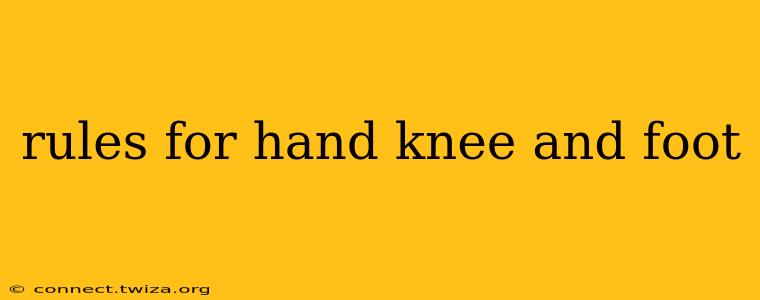Proper hand, knee, and foot placement is crucial for safety, efficiency, and injury prevention across a range of activities, from sports and exercise to everyday movements. This guide will explore the fundamental principles and considerations for optimal placement in different contexts. We'll delve into common questions and misconceptions to provide a comprehensive understanding.
What are the basic rules for hand, knee, and foot placement during exercise?
The basic rules for hand, knee, and foot placement during exercise hinge on maintaining proper alignment, balance, and stability. This involves:
- Stable Base: Ensure your hands, knees, and feet create a stable base of support, distributing your weight evenly. Avoid placing your weight solely on one limb or joint.
- Joint Alignment: Maintain proper alignment in your joints—wrists, elbows, knees, hips, ankles. Avoid hyper-extending or forcing joints into unnatural positions.
- Muscle Engagement: Actively engage the muscles surrounding the joints to support and stabilize them. This helps prevent injuries and improves performance.
- Activity-Specific Placement: The ideal placement will vary depending on the specific exercise. For example, a plank requires a straight line from head to heels, while a lunge requires a staggered stance with proper knee alignment.
- Listen to Your Body: Pay close attention to your body's signals. If something feels unstable or painful, adjust your placement or stop the exercise.
How should I position my hands, knees, and feet for proper posture?
Maintaining proper posture involves aligning your body segments—head, shoulders, spine, hips, knees, and feet—to minimize strain and optimize balance. Key considerations for hand, knee, and foot placement include:
- Feet: Should be shoulder-width apart, with your weight evenly distributed. Avoid pointing your toes inward or outward excessively.
- Knees: Should be slightly bent, with your kneecaps aligned over your second toes. Avoid locking your knees.
- Hands: Can be placed at your sides, on your hips, or resting comfortably, ensuring your shoulders are relaxed and not hunched.
What are common mistakes people make with hand, knee, and foot placement?
Many common mistakes stem from neglecting the principles mentioned above. These include:
- Uneven Weight Distribution: Placing too much weight on one limb can lead to imbalances and injuries.
- Poor Joint Alignment: Hyper-extending knees or elbows, or letting the knees cave inward during squats are common issues.
- Insufficient Muscle Engagement: This can result in poor stability and increased risk of injury.
- Ignoring Pain: Continuing an activity despite pain can lead to further damage.
How does proper hand, knee, and foot placement prevent injuries?
Proper placement helps prevent injuries by:
- Distributing weight evenly: Reducing stress on individual joints.
- Maintaining joint stability: Preventing excessive strain and potential tears or sprains.
- Promoting muscle engagement: Enhancing support and protection for joints.
- Improving balance and coordination: Reducing the risk of falls and other accidents.
Are there any differences in hand, knee, and foot placement for different sports or activities?
Yes, significantly. The optimal placement varies greatly depending on the specific activity:
- Running: Requires a midfoot strike to minimize impact, with feet landing beneath the hips.
- Yoga: Precise placement is vital for proper alignment in various poses.
- Weightlifting: Stance and grip vary depending on the exercise to maximize force and stability.
- Martial Arts: Specific stances and footwork are essential for balance, power, and defense.
Proper hand, knee, and foot placement is a fundamental aspect of many activities, impacting safety, performance, and injury prevention. By understanding and implementing these principles, you can improve your overall well-being and achieve better results. Remember to consult with professionals like physical therapists or coaches for personalized guidance and to address specific concerns.
